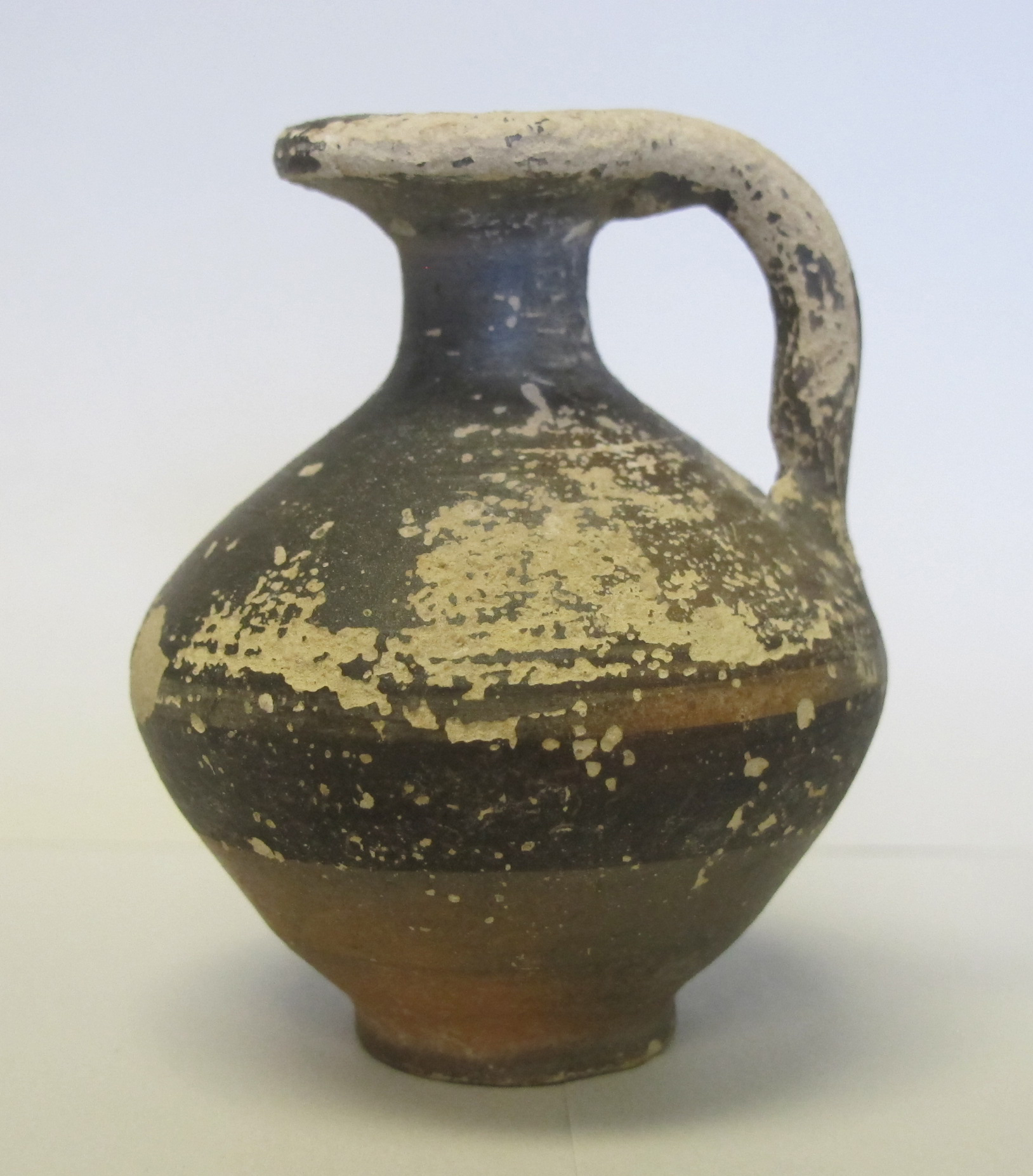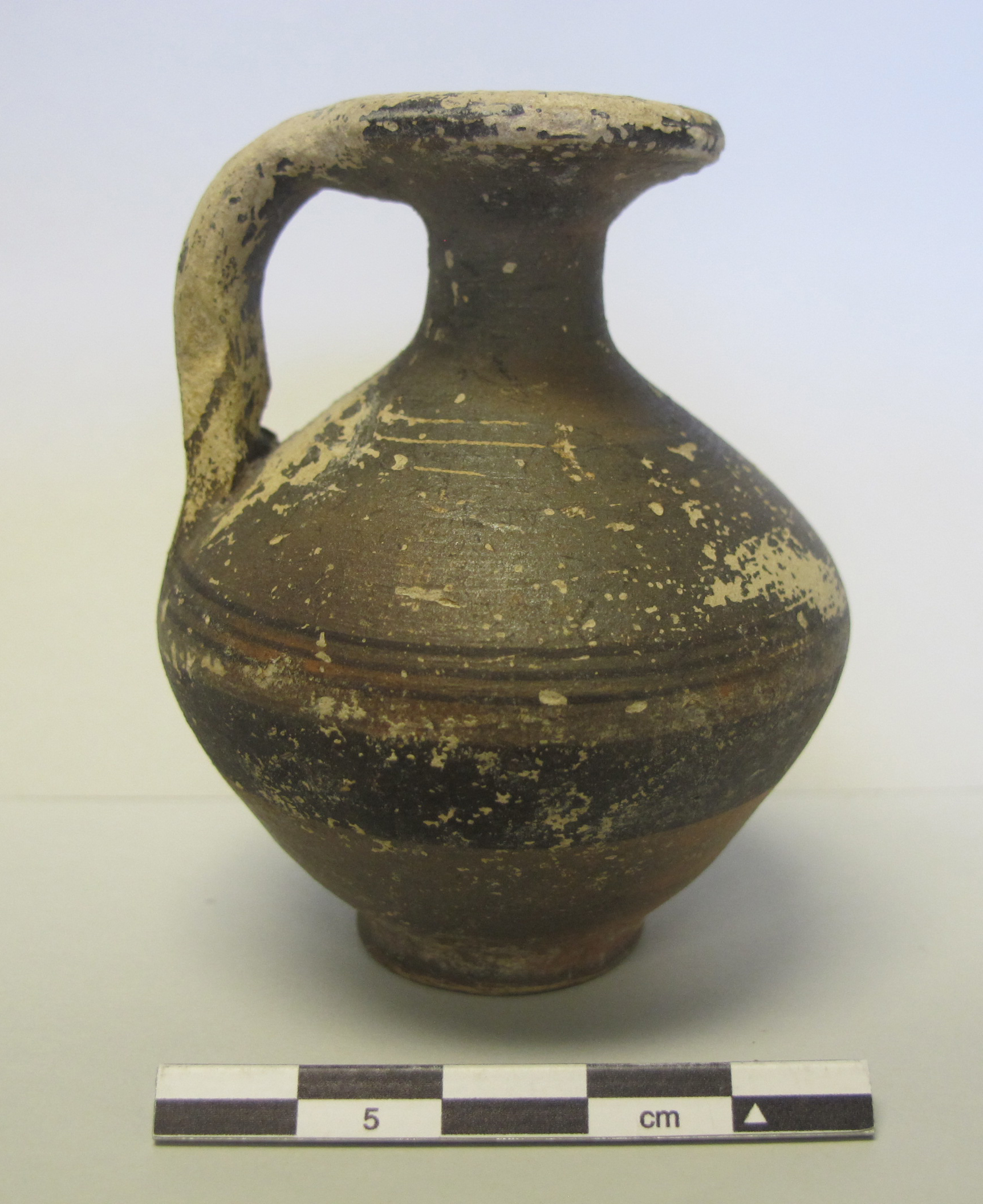For a 3D model made by the Virtual Curation Lab at Virginia Commonwealth University, see https://skfb.ly/orZCO
AWG0000.03.04
Aegean, Cypriot
Archaic period, Cypro-Archaic II (7th-5th century BCE)
Material: Ceramic
Style: Black-on-Red III
Weight: 50g
Dimensions: 6.5cm high, max. diameter 5cm
Condition: Fair condition. The paint has been rubbed off in some parts, showing the original ceramic fabric, but the piece is fully intact without any cracks.
Provenance: Unknown
Source/donor: Unknown
Date of acquisition: Unknown
Research by: Lindsey Stevens, ’23
Detailed description of form/shape:
Biconical body with flat base, narrow neck, wide flat lip, and vertical handle extending from the lip down to just above the widest part of the body. Buff fabric.
Detailed description of decoration:
A wide, matte brown-black band encircles the widest part of the lower half of the body, and three thin brown bands encircle the widest part of the upper half. The edge and top of the rim was also once painted dark brown, though the surface there has been worn down, as on the handle and in other places on the body, to the buff-colored clay. The parts not covered with matte dark bands were probably meant to be fired red (as in the Black-on-Red technique) but instead appear mostly gray, with the red only achieved on some parts of the lower body due to improper firing conditions.
Comparanda:
For an almost identical piece in shape, design, and decoration, see the Black-on-Red juglet British Museum 1894,1101.539, from Amathus, Cyprus. A similar vessel in the British Museum (1863,0728.86) excavated at Gela, Sicily, is identified as a aryballos and dated to the Hellenistic period, but the Cypro-Archaic juglet is a closer parallel for both shape and decoration. Another comparable Cypro-Archaic juglet is in the collection of the The Claremont Colleges’ Institute for Antiquity and Christianity, no. 77.1.14. This type was classified by Gjerstad as Black-on-Red III (V) (Schreiber 2003, fig. 6.4).
Discussion:
Because of its flat top and connected handle, this juglet may be considered an aryballos, a small vessel used to carry around oil, especially by ancient athletes. Its shape and decoration are closest to Black-on-Red Ware juglets made on Cyprus in the Archaic period, but it lacks the characteristic red background color, except in a few places on the lower part of the body. The color gradation at the bottom and gray areas along the bottom and neck result from lack of sufficient oxygen during the firing process (for experimental archaeology at Johns Hopkins demonstrating how misfirings can easily occur, see “Week 12-Slip Ups”).
Bibliography:
Aldoroty, Lauren. 2021. “Week 12 - Slip Ups.” Recreating Greek Ceramics. Johns Hopkins Archaeological Museum. Accessed May 4, 2022. https://archaeologicalmuseum.jhu.edu/class-projects/recreating-ancient-greek-ceramics/week-12-slip-ups/
“Aryballos.” Perseus Encyclopedia. The Perseus Digital Library, ed. Gregory R. Crane. https://www.perseus.tufts.edu/hopper/text?doc=Perseus:text:1999.04.0004:entry=aryballos
Getty Museum. “Making Greek Vases.” YouTube video, accessed May 4, 2022. https://www.youtube.com/watch?v=WhPW50r07L8
Smith, Joanna S. and Paula Waiman Barak. “Cypriot Iron Age Black-on-Red wares (BOR).” The Levantine Ceramics Project, accessed May 4, 2022. https://www.levantineceramics.org/wares/197-cypriot-iron-age-black-on-red-wares-bor
Schreiber, Nicola. 2003. The Cypro-Phoenician Pottery of the Iron Age. Leiden: Brill.


